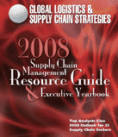
Visit Our Sponsors |
|
|
|
|
|
|
|
|
|
|
|
|
|
|
|
|
|
|
|
|
|
|
|
|
|
|
|
|
|
|
|
|
|
|
|
|
|
|
|
|
|
|
|
|
|
|
|
|
|
|
|
|
|
|
|
|
|
|
|
|

Analyst Insight
Companies are transforming their domestic and international supply chains at a rapid pace, driven by their suppliers and their customers both becoming globalized. Companies that have not started to look at strategies such as sales and operations planning, global supply chain visibility, and operational risk management are in danger of being outperformed by others who embraced these concepts.
-Nari Viswanathan, research director at Aberdeen Group
Aberdeen's survey of over 439 supply chain executives from all over the world found just how tough the business pressures have become in their global supply chains. Supply chain executives can play a critical role in aligning business strategy with supply chain goals. Fifty-six percent of surveyed companies regard supply chain management as a market strategy differentiator, a customer service differentiator or as a profit center, as opposed to strictly a cost of doing business. While companies across industries and regions continue to be confronted with inexorable escalations in supply chain costs, market realities such as globalization of supply, increasing competitive pressures, and dwindling product lifecycles demand that they transform their supply chains to balance cost reduction with strategic business alignment while performing at stellar levels.
Key Ingredients of Transformation Success
From these supply chain transformation pressures we can identify the key ingredients that are required for companies to achieve strategic supply chain success. These ingredients include:
• Supply chain responsiveness-supply chain visibility and agility combine to deliver a responsive supply chain that can quickly identify and react to changes in supply, demand, and execution threats/opportunities. This results in optimizing the use of enterprise resources while improving customer satisfaction.
• Strategic alignment with business objectives and internal stakeholders (finance, corporate, product engineering, etc)-a supply chain that is designed to support and drive business objectives becomes a strategic weapon in the marketplace enabling best-in-class execution.
• Integration/collaboration with trading partners-integrating end-to-end supply chain processes, including real-time collaboration with trading partners, is a critical element in extending the supply chain and leveraging the core domain expertise of each player.
• Gaining sustainability through green initiatives-sustainability and green are more than marketing buzzwords, they are imperatives for effective supply chain design and execution. Companies that learn to lower costs and improve performance through green initiatives will have a competitive advantage in the marketplace.
The Outlook
Participants were asked to list the top three application investment areas used to meet their key supply chain objective (e.g., lower cost or meet customer mandates). Companies ranked supply chain visibility at the top of the list. Sales and operations planning is at the number two position. Both of these areas are critical for companies to gain a competitive advantage while involved in global supply chain transformation.
RELATED CONTENT
RELATED VIDEOS
Timely, incisive articles delivered directly to your inbox.


